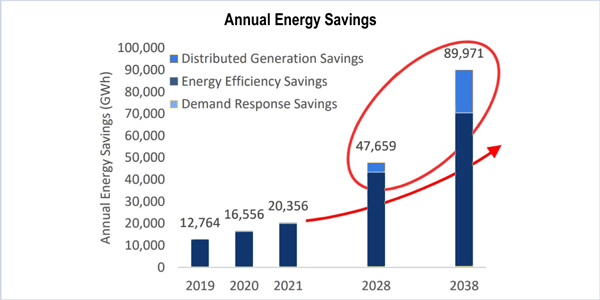By Amanda Durish Cook
An energy consulting firm thinks MISO has the potential for several gigawatts of demand-side energy savings by 2038, stakeholders learned Thursday.
The 20-year estimates of MISO’s future demand response, energy efficiency and distributed generation were produced by Applied Energy Group (AEG), with near final results presented to stakeholders at a special March 22 conference call. The commissioned study will inform the RTO’s 2019 Transmission Expansion Plan, with researchers using the conditions from four MTEP future predictions to project likely demand-side management.
By 2038, total demand-side management could reduce MISO peak summer demand by 22.5 GW, or about 15%, with 11.3 GW of the energy savings from energy efficiency, 7.2 GW from DR and 4 GW from distributed generation. Next year, AEG predicts MISO will save about 8.2 GW on summer peak demand from demand-side management.
In two decades, energy efficiency will be responsible for a 69,899-GWh annual energy savings in MISO; distributed generation will account for a 19,566-GWh annual savings; and DR programs will yield a 539-GWh annual savings. The 89,971-GWh savings total by 2038 is a more than seven-fold increase from AEG’s expected 12,764-GWh savings in 2019.
AEG predicts that Michigan, Minnesota, Iowa and Wisconsin have the most potential for energy savings through the next 20 years.
Some stakeholders commented that there was virtually no way to verify AEG’s forecasted values with what transpires because behind-the-meter activity is expected to remain largely undocumented.
AEG Managing Director Michael Daukoru said his firm examined both regional and state-specific customer adoption trends along with various state incentives, costs of programs, utility-provided forecasts and capacity growth rates in the study.
MISO staff have said the trickiest part of load forecasting is capturing and projecting the footprint’s unknown amount of demand-side management. (See MISO Looks to Align Load Forecasting, Tx Planning.)
The study found that energy efficiency provides the most significant magnitude of demand and energy savings resources.
“Energy efficiency in our view will continue to play a critical role in demand-side management,” Daukoru said. “EE is quite significant in terms of savings.”
Daukoru predicted that residential behavioral programs that encourage improvements in energy efficiency and home weatherization programs will continue to gain popularity within MISO. New federal lighting standards in 2020 and efficiency upgrades to existing buildings and equipment will also play a role in energy efficiency, the study found.
Distributed resources, driven by rooftop solar, will impact peak loads. MISO will continue to see rapid adoption of distributed generation with the rapidly declining cost of residential rooftop solar, Daukoru said. Distributed wind, on the other hand, is expected to remain prohibitively expensive for most residents.
Combined heat and power is already at high saturation point in parts of MISO, including Texas, Louisiana and Michigan. Expensive installation costs limit more adoption, Daukoru said.
The study found that MISO has room for “significant” DR opportunities, despite “several mature” programs in certain states. AEG expects residents in the footprint to participate in expanded direct load control programs within two decades, installing connected thermostats and smart water heaters that can be automated to turn off in response to reliability threats or energy price spikes.
AEG said utility-led dynamic pricing programs will be emerging only “from isolated pilots.”
“There is enormous potential for dynamic pricing, but it requires political will,” said AEG Senior Vice President Ingrid Rohmund.
Customized Energy Solutions’ David Sapper asked if AEG considered how the federal push to value resilience might affect the adoption of demand-side management in MISO.
“I have not given that much thought,” Daukoru said. “That was not accounted for in our analysis.”
Daukoru added that demand-side resources could be valuable to resilience given their ability to deliver energy savings and render loads more flexible.
AEG’s study will be finalized in June and included in the MTEP studies. MISO and AEG will continue to refine study assumptions for behind-the-meter participation and the potential impact of electric vehicle adoption over the next few weeks.



